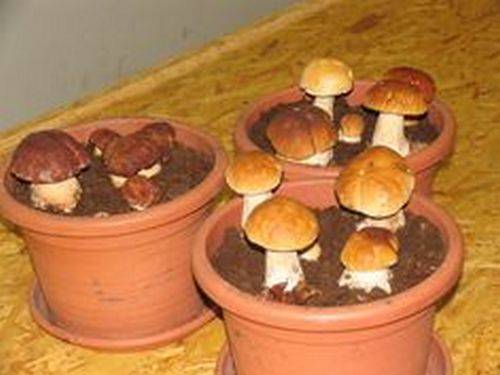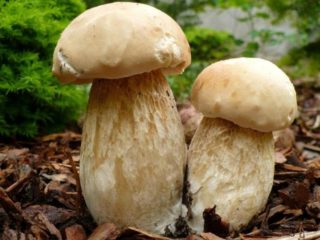Content
Porcini mushroom is a desirable catch for any mushroom picker. Strong, beautiful boletus mushrooms just beg to be added to the basket. But they are found in the forest less and less often. This is due to the reduction of forest area, poor ecology and many other reasons. Therefore, many lovers of this forest delicacy are increasingly thinking about how to grow porcini mushrooms at home. And if you have such a desire and opportunity, you should definitely do this, because regular use of this product brings great health benefits.
Benefits of porcini mushrooms
- Increases immunity.
- Helps in the fight against atherosclerosis and angina pectoris.
- Good prevention in the fight against cancer.
- Contain a large amount of vitamins and microelements.
If you decide to organize the cultivation of porcini mushrooms at home, you should familiarize yourself with the biology of boletus mushrooms so as not to make mistakes.
Mass production of boletus mushrooms industrially is not justified due to its complexity and high cost.But it is quite possible to grow them in small quantities.
Characteristics of boletus
The porcini mushroom belongs to the tubular mushrooms and is a symbiont - its mycelium grows together with the root system of the tree under which it grows. They exchange nutrients for mutual benefit. Each type of boletus forms a symbiosis with a certain type of tree.
This is one of the few mushrooms that are tolerant of bright sun; it grows well in illuminated meadows. Boletus mushrooms can also live in the shade, but they feel much worse there; they can only be found in shady places in a harvest year. The boletus does not like very wet places, but it will not grow without water at all. Porcini mushroom does not tolerate extreme heat and low daily temperatures. In summer it grows best at 15-18 degrees Celsius; in autumn 10 degrees is enough for it. To grow to the size of an adult mushroom (a cap up to 50 cm in diameter and a stem up to 25 cm high and up to 5 cm in diameter), it takes a boletus a whole week. The best soils for it are sandy, sandy loam and loam.
When we know what conditions need to be created for the successful growth of boletus mushrooms, let’s try to grow porcini mushrooms at home.
There are two ways to breed this mushroom delicacy:
- extensive - boletus mushrooms are grown on their own plot under natural conditions;
- intensive – growing in closed spaces in which the necessary conditions are created by humans.
Let's look at each method in more detail.
How to grow boletus mushrooms on the plot
This growing method is seasonal.Success in this matter can be achieved provided that there are suitable trees on the site, next to which the boletus will be comfortable. In nature, they most often grow under birch, oak, pine and spruce trees. Young trees between 5 and 10 years old are most suitable. They may be older, but not younger than 5 years. The porcini mushroom does not have symbiosis with the roots of young trees.
In an area that is suitable in all respects, we dig up the soil without turning over the formation. It is necessary to choose weeds. If there is no rain, the area needs to be moistened. Further preparation of the site depends on the method in which boletus mushrooms are going to be propagated.
Methods for propagating porcini mushrooms
- store-bought mycelium;
- fragments of mycelium brought from the forest;
- mushroom material brought from the forest.
In the first and second cases, the soil must be made nutritious using specially prepared compost. It is made from leaves, pieces of bark beginning to rot with the addition of a small amount of horse manure.
In order for the compost to ripen faster, it needs to be moistened from time to time with a weak solution of ammonium nitrate with a concentration of 1%.
Setting up a bed for planting boletus
Take out the soil in the chosen place to a depth of 20 cm and set it aside. Fill the bed layer by layer with compost and selected soil. The mycelium of porcini mushrooms is simply laid out on top of the soil, deepening it by 7 cm, in accordance with the standards indicated on the packaging.
Fresh manure is not suitable for this. It is much better if it is fully ripened humus. To enrich it with beneficial bacteria, spill it with a solution of EM preparations according to the instructions.
If mushrooms are propagated by soil with part of the mycelium, and for this a layer measuring 15 by 25 cm is sufficient, it is divided into 10-15 fragments, laid out at equal distances over the area of the bed and also sprinkled with a little soil. The soil is well moistened. The mycelium is taken under the appropriate tree in the forest, under which porcini mushrooms grow. The layer must be cut off carefully and be sure to fill the damaged area with fresh soil so that the harm caused to nature is minimal.
To keep the moisture longer, it is good to mulch the bed with dry leaves or moss.
Boletus mushrooms can be propagated by fragments of mushroom bodies. There are two methods - dry and wet.
- With the dry method, you can place whole caps of fully mature mushrooms or pieces of them on the selected place, the spore layer should be at the bottom. Lightly sprinkle them with soil. You can place the mushroom caps on a sheet of clean paper and let them dry well in the sun, and then plant them.
- The wet method has been known since ancient times. Fully ripe and even overripe porcini mushrooms were placed in a wooden bowl and filled with soft rainwater for a day. Added 3-4 tbsp. spoons of sugar or alcohol. The mixed infusion was filtered through cheesecloth and watered over the bed prepared for planting.
For example, when planting under an oak tree, collect porcini mushrooms grown in the oak forest.
With successful early planting, you can expect a harvest already in the first year, but sometimes this process drags on for 2 or even 3 years.
Growing porcini mushrooms indoors
Greenhouses, basements, hangars, and sheds are suitable for this. The main thing is the ability to create conditions suitable for growing mushrooms, namely a temperature within 8-12 degrees Celsius and a humidity of about 90%.
A very important point is proper lighting. The light should be diffused and dim. It is required by mushrooms after the appearance of fruiting bodies. Until this moment, the room may not be illuminated at all.
Stages of preparing and growing boletus mushrooms indoors
Greenhouses are best suited for this. In the southern regions, a simple polycarbonate greenhouse is sufficient. In more northern areas, heating will have to be provided. And where it is very cold, it is easier to install it in a room in which it is easy to regulate the temperature.
- Choosing a room for growing.
- If necessary, we install a heating system.
- We take care to maintain the required level of humidity.
The easiest way is to place vessels with water, between which there should be a distance of about 2 m, or containers with constantly moistened sawdust. - We achieve the correct lighting. If necessary, we put light-proof materials on top of the greenhouse or those that transmit only diffused light. For already sprouted mushrooms, it is enough to turn on low intensity light for 4 hours a day.
- We install a ventilation system. In cold weather, the supply air must be heated.
- We are preparing containers for growing porcini mushrooms. Disinfected wooden boxes mounted on special shelves are suitable for this.
- Proper soil is one of the most important components of success. It is prepared in advance. Soil components: fertile soil, a small amount of sawdust and horse manure or humus.
- To prevent sawdust from absorbing a lot of nitrogen when rotting, it is better to moisten it with a weak solution of ammonium nitrate. The prepared soil must mature for at least one week.
- Fill the boxes with prepared soil.
- When everything is ready, we purchase mushroom mycelium. Boletus mushrooms brought from the forest are not suitable for growing mushrooms at home. In Holland, intensive technologies have already been developed for growing this forest delicacy. Special races of porcini mushrooms have also been bred, most suitable for home use. If possible, it is best to use Dutch mycelium.
- We buy the required amount of mycelium, grind it without removing it from the bags.
- Distribute evenly over the surface of the substrate in accordance with the instructions. Mix with soil. We monitor the humidity of the substrate. The layer of soil above the mycelium should not be thicker than 7 cm.
- We monitor all the parameters in the room where mushrooms are grown and wait for the harvest.
To imagine the process of growing mushrooms more clearly, you can watch the video:
The technology for growing porcini mushrooms at home is much more complex than that for growing champignons. It requires large initial costs and time. But all this pays off in the result obtained.For those who have not yet engaged in home mushroom growing, it is better to start by growing mushrooms on the plot. And experienced mushroom growers can receive quite a significant income from their indoor plantations.



















